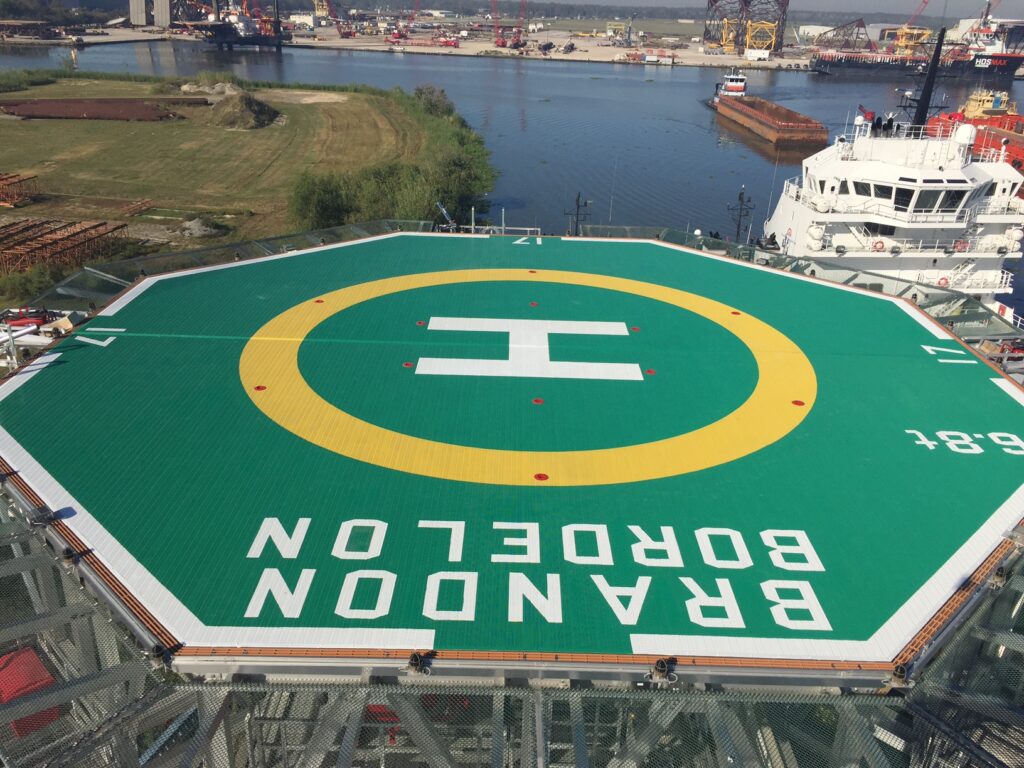Navigating the skies in a helicopter requires a unique set of skills, and landing safely is perhaps the most critical of them all. Helipads and helidecks serve as the designated landing zones, and their markings are more than just paint on a surface. They are a set of visual cues, a language that pilots must understand to ensure safe and precise landings. In this comprehensive guide, we’ll explore the various types of markings you’ll find on helipads and helidecks, what they mean, and why they are essential for aviation safety.
The “H” Marking: The Heart of the Helipad
At the core of every helipad is the iconic “H” marking, but its presentation varies depending on the location. On offshore helidecks, the “H” is often encircled, providing a clear visual boundary for pilots as they approach over open water. On onshore helipads, the “H” is typically accompanied by a cross, serving as an additional visual cue for pilots navigating more varied landscapes. These variations are not mere stylistic choices; they are carefully calibrated according to international standards, such as those set by the International Civil Aviation Organization (ICAO) or the Federal Aviation Administration (FAA) in the United States.
The Touchdown and Lift-Off Area (TLOF)
Surrounding the “H” is the Touchdown and Lift-Off Area (TLOF), a zone that is free of any obstructions and is designed to support the full weight of the helicopter. The TLOF is often marked by a solid or dashed circle, which serves as a visual boundary for pilots. This circle is not just an arbitrary shape; its diameter is calculated based on the type and size of helicopters that will be using the helipad. For elevated helipads or helidecks, such as those found on offshore platforms or rooftops, the TLOF markings may also include a yellow perimeter line for added visibility.
The Final Approach and Takeoff Area (FATO)
Beyond the TLOF lies the Final Approach and Takeoff Area (FATO), a larger zone that provides additional space for the helicopter’s approach and departure paths. The FATO is often marked by segmented lines or corner markers, which help pilots gauge their alignment and altitude during the final stages of landing. This area is crucial for maneuvering, especially in challenging weather conditions or during emergency situations.
Aiming Circles and Compass Roses
Some helipads feature additional markings known as aiming circles and compass roses. An aiming circle is a smaller circle within the TLOF, providing an extra visual cue for pilots during the landing phase. A compass rose, on the other hand, is a directional marking that indicates the cardinal points of North, South, East, and West. This is particularly useful for pilots in maintaining orientation, especially when landing on offshore platforms where visual references may be limited.
The Palette of Safety
The choice of colors for helipad markings is a matter of both visibility and safety. White and yellow are the most commonly used colors due to their high contrast against various backgrounds. However, in specific environments such as snow-covered regions or sandy deserts, alternative colors may be used to achieve better contrast. Offshore, it’s crucial to avoid using blue, as it fails to provide sufficient contrast against the ocean’s surface.
Exit Markings and Vessel Identification
In the context of offshore helidecks, additional markings indicate the locations of exits, usually leading to stairways or other escape routes. These are vital for both pilots and passengers, providing quick orientation in case of an emergency. Furthermore, the name of the vessel or rig is often prominently displayed, serving as an immediate identifier for pilots approaching from the air.
Meters vs. Feet
Another noteworthy aspect is the marking that indicates the parameters of the helipad. Overseas, these are usually expressed in meters, while in the United States, feet are the standard unit of measurement. This information is crucial for pilots to gauge whether their helicopter can safely land on the helipad, taking into account the rotor diameter and overall size of the aircraft.
Lighting: The Veins of the Helipad
While markings are the bones of a helipad, lighting serves as its veins, illuminating the landing zone and guiding pilots during nighttime or low-visibility conditions. Perimeter lights, floodlights, and even infrared lights for military operations are strategically placed to enhance the visibility of the helipad markings. Special attention is given to the color, intensity, and placement of these lights to ensure they complement, rather than obscure, the painted markings.
Regulatory Oversight
It’s worth noting that helipad and helideck markings are subject to stringent regulations. Organizations like the ICAO, FAA, and the European Union Aviation Safety Agency (EASA) have laid down specific guidelines that cover everything from the dimensions and colors of markings to the types of paint materials that should be used. Compliance with these regulations is not just a legal requirement but a moral obligation to ensure the safety of pilots and passengers alike.
In the grand tapestry of aviation, helipad and helideck markings may seem like minor details. Yet, they are the threads that hold the fabric together, the silent language that speaks volumes, guiding pilots safely back to earth. As we navigate the complex skies, let us not forget these humble markings, for they are the signposts that lead us home.

